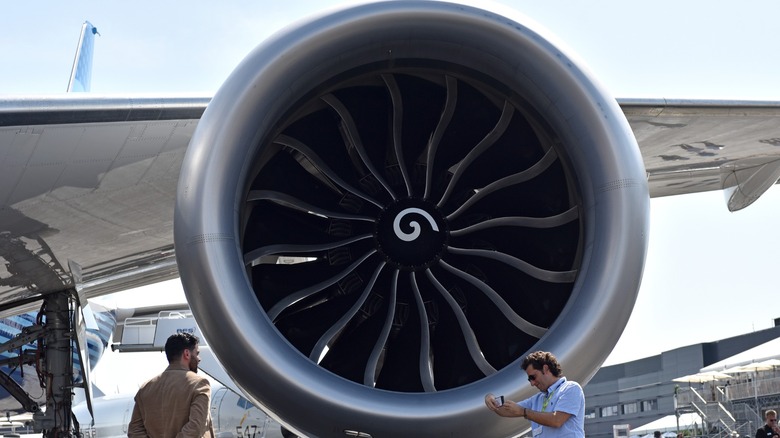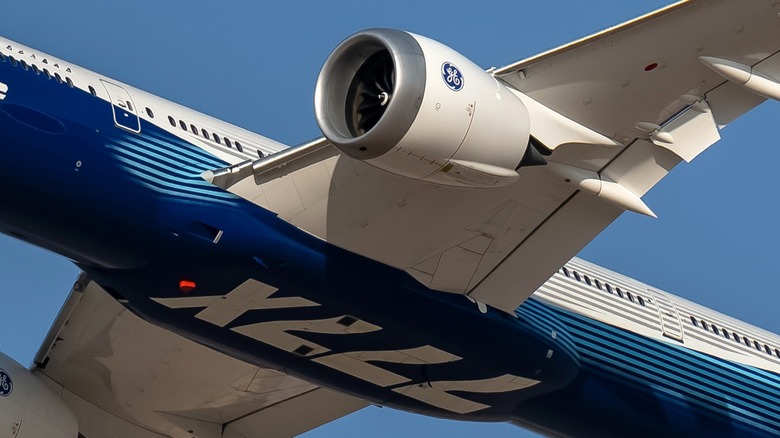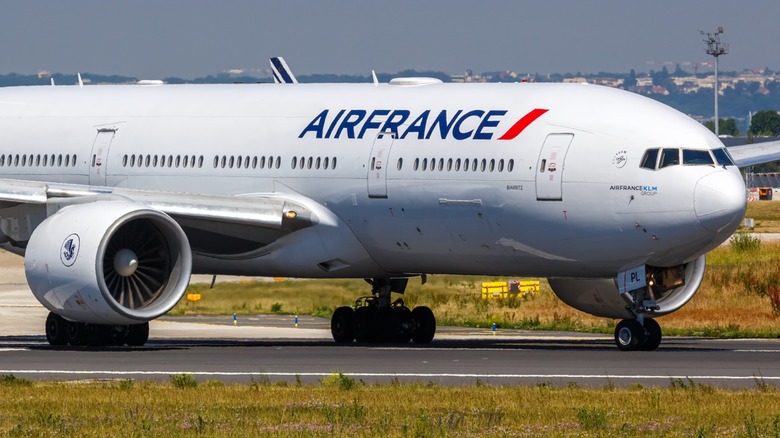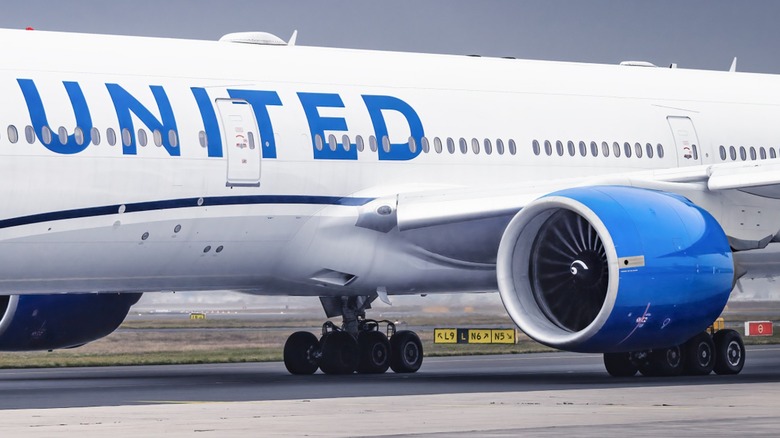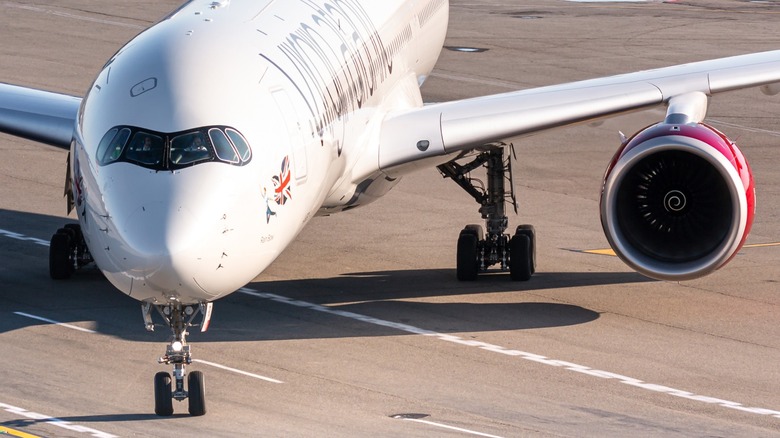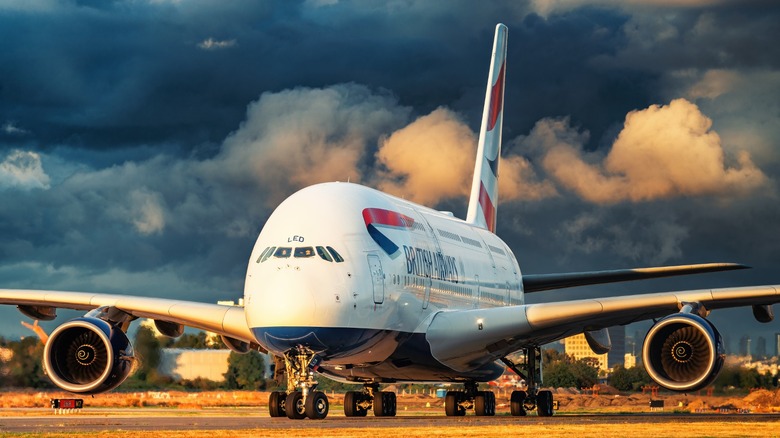5 Of The Most Powerful Jet Engines You Can Find On Commercial Planes
Commercial aviation has made the world smaller, allowing more people than ever before to fly on larger airplanes at a lower price. The increased demand for air travel means that airplane makers always need bigger and better jet engines to bring these airframes to the sky. While the two largest passenger planes to enter service — the Airbus A380 and the Boeing 747 — have been discontinued by manufacturers, larger and more powerful jet engines are still coming into service today.
These engines are more than just powerful — they're also far more fuel efficient, too, than the first-generation turbofan and turbojet engines that ushered in the jet age. This allows for passenger jets with mind-boggling range such as the A350-900 ULR, which can fly non-stop for 20 hours, giving it a range of 9,700 nautical miles. If you want to know more about the engines that push these planes into the sky, here's our list of the five most powerful jet engines you can find on modern commercial planes today.
General Electric GE9X
The GE9X is GE Aerospace's latest engine model, and it is specifically built for the Boeing 777X. Although the 777X project has long been delayed, it has already taken to the skies with its GE9X engines, making these the most powerful turbines to ever be mounted on an airliner. This engine reaches a maximum of 134,300 pounds of thrust. It's also one of the largest engines ever made, with a fan diameter of 11.2 feet, making it wider than the fuselage of a Boeing 737.
Aside from all that power, the engine also offers better efficiency in several ways. First off, it has 10% less fuel burn compared to its predecessor, the GE90-115B. It also has reduced carbon dioxide, nitrogen oxide, and noise emissions, making it better for the environment. GE was able to achieve this by using composite materials, like ceramic matrix composites and carbon fiber to reduce weight without sacrificing strength.
General Electric GE90
The GE90 was the most powerful turbofan engine ever made before it was surpassed by the GE9X. The first widely adopted variant of the GE90 is the 94B engine, which was one of the engine options for the Boeing 777-200 and the 777-300. This iteration delivered 93,700 lbs. of thrust via its 10.2-foot fan. When Boeing wanted to make longer range variants of its venerable wide-body twinjet, it again tapped GE to make the GE90-115B.
The GE90-115B delivers 115,300 lbs. of thrust at maximum power from its 128-inch (10.7-foot) fan, and you can find it on the Boeing 777-200LR, 777-300ER, and 777 Freighter. Despite being larger and more powerful than the GE90-94B, it offered a 3.6% reduction in fuel burn while delivering a 99.98% reliability rate.
Aside from power, the GE90 is also one of the first engines to get a 330-minute ETOPS rating. That means that the engine is capable of flying five and a half hours to a suitable diversion landing field in the case of emergency, allowing aircraft outfitted with the GE90 to operate safely on almost any global route.
Pratt & Whitney PW4000 Family
Pratt & Whitney introduced the PW4000 engine family in April 1984 with the PW4000-94, which is used with several aircraft including the Airbus A330, Boeing 747-400, and McDonnel Douglas MD-11 widebody jets. As of 2024, this turbine engine is available in three variants: the PW4000-94, the PW4000-100, and the PW4000-112.
The PW4000-94, the smallest engine in the family with a 94-inch fan diameter and is rated for 52,000 to 62,000 lbs. of thrust. The PW4000-100 in 1991 was designed to serve as one of the main engine options for the upcoming Airbus A330, in the process upping the output to 64,000 to 68,000 lbs. of thrust. Finally, the PW4000-112, entered service in 1995 with the Boeing 777, delivering a thrust range of 84,000 to 98,000 lbs.
This makes the largest variant of the PW4000 one of the most powerful engines hanging under the wings of a plane. Beyond its power output, the PW4000 is a popular engine option because of its availability and commonality between aircraft types. Since you can get it as an option for many Airbus and Boeing jets, airlines that operate compatible aircraft types would likely choose it to make training, maintenance, and logistics easier.
Rolls Royce Trent Series
In February 1995, the very first Trent engine took flight under the wing of a Cathay Pacific Airbus A330 when the airline took delivery of the plane from the Airbus production center in Toulouse. Almost three decades later, the Trent family offers seven different models — the Trent 500, Trent 700, Trent 800, Trent 900, Trent 1000, Trent XWB, and Trent 7000. The most powerful of the bunch is the Trent XWB, which was designed specifically for the Airbus A350XWB.
The Trent XWB has two variants. The first is the Trent XWB-84, which outputs 84,000 lbs. of thrust for the Airbus A350-900. Next is the Trent XWB-97, which has a higher thrust output of 97,000 lbs., helping it propel the larger A350-1000 and A350F Freighter. Despite their differing outputs, both Trent XWB engines use a three-meter diameter fan with 22 blades that move at 2,700 rpm.
Next to the Trent XWB is the Trent 800, which is also one of the engine options on the original Boeing 777 variants. The Trent 800 is rated for 75,000 to 95,000 lbs. of thrust. Despite having a slightly lower output than the Trent XWB, the Trent 800 is lighter by up to 8,000 lbs, making it one of the most fuel-efficient engines available for the 777.
Engine Alliance GP7200
The Airbus A380 is the largest passenger aircraft to ever take flight, but so you probably expected it to have the most powerful commercial engines. However, since it has four engines instead of the usual two, it didn't need that much thrust coming from each individual engine. There are two types of engines used for this plane – Rolls-Royce delivered the Trent 900, while Pratt & Whitney collaborated with GE to form Engine Alliance and offer the GP7200.
Pratt & Whitney built the fan and gearbox of the GP7200, while the combustor, high-pressure turbine, and digital engine controls were built by GE. It doesn't have the much thrust compared to some of the other powerplants on our list, but it still delivers a respectable 70,000 to 81,500 pounds of thrust using a 116-inch fan. However, since Airbus has ended the A380 program, the manufacture of new GP7200 engines seems to have ended as well, and each airframe retirement means there will be four less GP7200s in service. Nevertheless, Engine Alliance is still around and has pivoted towards servicing the existing fleet of Airbus A380 engines.
